|
|
The Third Report of the Expert Panel on Detection, Evaluation, and
Treatment of High Blood Cholesterol in Adults (Adult Treatment Panel III,
or ATP III) constitutes the National Cholesterol Education Program’s
(NCEP’s) updated clinical guidelines for cholesterol testing and management.
The full ATP III document is an evidence-based and extensively
referenced report that provides the scientific rationale for the recommendations
contained in the executive summary. ATP III builds on previous
ATP reports and expands the indications for intensive cholesterol-lowering
therapy in clinical practice. It should be noted that these guidelines are
intended to inform, not replace, the physician’s clinical judgment, which
must ultimately determine the appropriate treatment for each individual.
The third ATP report updates the existing recommendations for clinical
management of high blood cholesterol. The NCEP periodically produces
ATP clinical updates as warranted by advances in the science of cholesterol
management. Each of the guideline reports—ATP I, II, and III—has a major
thrust. ATP I outlined a strategy for primary prevention of coronary heart
disease (CHD) in persons with high levels of low density lipoprotein (LDL)
cholesterol ( 160 mg/dL)
or those with borderline-high LDL cholesterol
(130-159 mg/dL) and multiple (2+) risk factors. ATP II affirmed the importance
of this approach and added a new feature: the intensive management
of LDL cholesterol in persons with established CHD. For CHD patients,
ATP II set a new, lower LDL cholesterol goal of 160 mg/dL)
or those with borderline-high LDL cholesterol
(130-159 mg/dL) and multiple (2+) risk factors. ATP II affirmed the importance
of this approach and added a new feature: the intensive management
of LDL cholesterol in persons with established CHD. For CHD patients,
ATP II set a new, lower LDL cholesterol goal of
 100 mg/dL. ATP III adds
a call for more intensive LDL-lowering therapy in certain groups of people,
in accord with recent clinical trial evidence, but its core is based on ATP I
and ATP II. Some of the important features shared with previous reports are
shown in Table A in the Appendix. 100 mg/dL. ATP III adds
a call for more intensive LDL-lowering therapy in certain groups of people,
in accord with recent clinical trial evidence, but its core is based on ATP I
and ATP II. Some of the important features shared with previous reports are
shown in Table A in the Appendix.
While ATP III maintains attention to intensive treatment of patients with
CHD, its major new feature is a focus on primary prevention in persons
with multiple risk factors. Many of these persons have a relatively high risk
for CHD and will benefit from more intensive LDL-lowering treatment than
recommended in ATP II. Table 1 shows the new features of ATP III.
Page 1
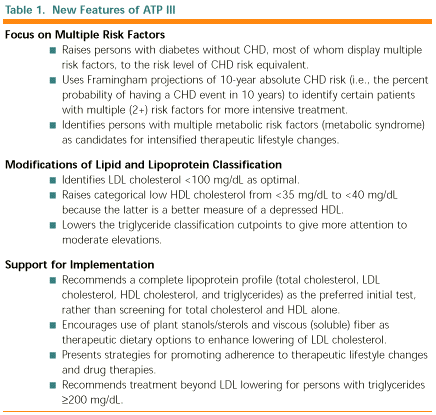
Research from experimental animals, laboratory investigations, epidemiology,
and genetic forms of hypercholesterolemia indicate that elevated LDL cholesterol
is a major cause of CHD. In addition, recent clinical trials robustly
show that LDL-lowering therapy reduces risk for CHD. For these reasons,
ATP III continues to identify elevated LDL cholesterol as the primary target of
cholesterol-lowering therapy. As a result, the primary goals of therapy and the
cutpoints for initiating treatment are stated in terms of LDL.
A basic principle of prevention is that the intensity of risk-reduction therapy
should be adjusted to a person’s absolute risk. Hence, the first step in
selection of LDL-lowering therapy is to assess a person’s risk status. Risk
assessment requires measurement of LDL cholesterol as part of lipoprotein
analysis and identification of accompanying risk determinants.
Page 2
In all adults aged 20 years or older, a fasting lipoprotein profile (total
cholesterol, LDL cholesterol, high density lipoprotein (HDL) cholesterol,
and triglyceride) should be obtained once every 5 years. If the testing opportunity
is nonfasting, only the values for total cholesterol and HDL cholesterol
will be usable. In such a case, if total cholesterol is
 200 mg/dL or HDL is <40 mg/dL, a followup lipoprotein profile is needed for appropriate
management based on LDL. The relationship between LDL cholesterol
levels and CHD risk is continuous over a broad range of LDL levels from
low to high. Therefore, ATP III adopts the classification of LDL cholesterol
levels shown in Table 2, which also shows the classification of total and
HDL cholesterol levels.
200 mg/dL or HDL is <40 mg/dL, a followup lipoprotein profile is needed for appropriate
management based on LDL. The relationship between LDL cholesterol
levels and CHD risk is continuous over a broad range of LDL levels from
low to high. Therefore, ATP III adopts the classification of LDL cholesterol
levels shown in Table 2, which also shows the classification of total and
HDL cholesterol levels.
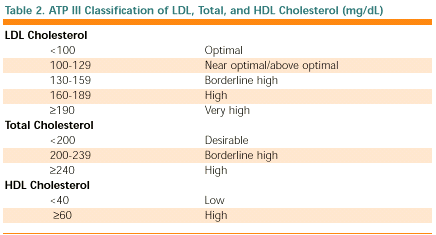
Risk determinants in addition to LDL-cholesterol include the presence or
absence of CHD, other clinical forms of atherosclerotic disease, and the
major risk factors other than LDL (see Table 3). (LDL is not counted
among the risk factors in Table 3 because the purpose of counting those
risk factors is to modify the treatment of LDL.) Based on these other risk
determinants, ATP III identifies three categories of risk that modify the
goals and modalities of LDL-lowering therapy. Table 4 defines these
categories and shows corresponding LDL-cholesterol goals.
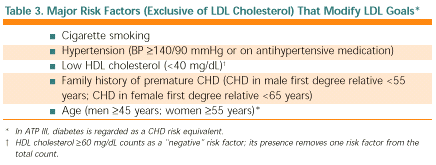
Page 3

The category of highest risk consists of CHD and CHD risk equivalents.
The latter carry a risk for major coronary events equal to that of established
CHD, i.e., >20% per 10 years (i.e., more than 20 of 100 such individuals
will develop CHD or have a recurrent CHD event within 10 years). CHD
risk equivalents comprise:
Other clinical forms of atherosclerotic disease (peripheral arterial disease,
abdominal aortic aneurysm, and symptomatic carotid artery disease);
Diabetes;
Multiple risk factors that confer a 10-year risk for CHD >20%.
Diabetes counts as a CHD risk equivalent because it confers a high risk of
new CHD within 10 years, in part because of its frequent association with
multiple risk factors. Furthermore, because persons with diabetes who
experience a myocardial infarction have an unusually high death rate either
immediately or in the long term, a more intensive prevention strategy is
warranted. Persons with CHD or CHD risk equivalents have the lowest
LDL cholesterol goal (<100 mg/dL).
The second category consists of persons with multiple (2+) risk factors in
whom 10-year risk for CHD is  20%. Risk is estimated from Framingham
risk scores (see Appendix). The major risk factors, exclusive of elevated
LDL cholesterol, are used to define the presence of multiple risk factors that
modify the goals and cutpoints for LDL-lowering treatment, and these are
listed in Table 3. The LDL cholesterol goal for persons with multiple (2+)
risk factors is <130 mg/dL.
The third category consists of persons having 0-1 risk factor; with few
exceptions, persons in this category have a 10-year risk <10%. Their LDL
cholesterol goal is <160 mg/dL. 20%. Risk is estimated from Framingham
risk scores (see Appendix). The major risk factors, exclusive of elevated
LDL cholesterol, are used to define the presence of multiple risk factors that
modify the goals and cutpoints for LDL-lowering treatment, and these are
listed in Table 3. The LDL cholesterol goal for persons with multiple (2+)
risk factors is <130 mg/dL.
The third category consists of persons having 0-1 risk factor; with few
exceptions, persons in this category have a 10-year risk <10%. Their LDL
cholesterol goal is <160 mg/dL.
Risk status in persons without clinically manifest CHD or other clinical
forms of atherosclerotic disease is determined by a 2-step procedure.
Page 4
First, the number of risk factors is counted (Table 3). Second, for persons
with multiple (2+) risk factors, 10-year risk assessment is carried out
with Framingham scoring (see Appendix) to identify individuals whose
short-term (10-year) risk warrants consideration of intensive treatment.
Estimation of the 10-year CHD risk adds a step to risk assessment beyond
risk factor counting, but this step is warranted because it allows better
targeting of intensive treatment to people who will benefit from it. When
0-1 risk factor is present, Framingham scoring is not necessary because
10-year risk rarely reaches levels for intensive intervention; a very high
LDL level in such a person may nevertheless warrant consideration of drug
therapy to reduce long-term risk. Risk factors used in Framingham scoring
include age, total cholesterol, HDL cholesterol, blood pressure, and
cigarette smoking. Total cholesterol is used for 10-year risk assessment
because of a larger and more robust Framingham database for total than
for LDL cholesterol, but LDL cholesterol is the primary target of therapy.
Framingham scoring divides persons with multiple risk factors into those
with 10-year risk for CHD of >20%, 10-20%, and <10%. It should be
noted that this 2-step sequence can be reversed with essentially the same
results.* Initial risk assessment in ATP III uses the major risk factors to
define the core risk status. Only after the core risk status has been
determined should any other risk modifiers be taken into consideration for
adjusting the therapeutic approach.
* If Framingham scoring is carried out before risk factor counting, persons with
<10 percent risk are then divided into those with 2+ risk factors and 0-1 risk
factor by risk factor counting to determine the appropriate LDL goal (see Table 4).
Page 5
ATP III recognizes that risk for CHD is influenced by other factors not
included among the major, independent risk factors (Table 3). Among these
are life-habit risk factors and emerging risk factors. The former include
obesity, physical inactivity, and atherogenic diet; the latter consist of
lipoprotein (a), homocysteine, prothrombotic and proinflammatory factors,
impaired fasting glucose, and evidence of subclinical atherosclerotic disease.
The life-habit risk factors are direct targets for clinical intervention, but are
not used to set a lower LDL cholesterol goal of therapy. The emerging risk
factors do not categorically modify LDL cholesterol goals; however, they
appear to contribute to CHD risk to varying degrees and can have utility in
selected persons to guide intensity of risk-reduction therapy. Their presence
can modulate clinical judgment when making therapeutic decisions.
Many persons have a constellation of major risk factors, life-habit risk
factors, and emerging risk factors that constitute a condition called the
metabolic syndrome. Factors characteristic of the metabolic syndrome are
abdominal obesity, atherogenic dyslipidemia (elevated triglyceride, small
LDL particles, low HDL cholesterol), raised blood pressure, insulin
resistance (with or without glucose intolerance), and prothrombotic and
proinflammatory states. ATP III recognizes the metabolic syndrome as a
secondary target of risk-reduction therapy, after the primary target—LDL
cholesterol. Diagnosis and treatment of the metabolic syndrome is described
beginning on page 15 under “Benefit Beyond LDL Lowering: The
Metabolic Syndrome as a Secondary Target of Therapy.”
In ATP III, a primary aim is to match intensity of LDL-lowering therapy
with absolute risk. Everyone with elevated LDL cholesterol is treated with
lifestyle changes that are effective in lowering LDL levels. Persons at
relatively high risk are also candidates for drug treatment, which is very
effective but entails significant additional expense. The cutpoints for drug
treatment are based primarily on risk-benefit considerations: those at higher
risk are likely to get greater benefit. However, cutpoints for recommended
management based on therapeutic efficacy are checked against currently
accepted standards for cost effectiveness. Lifestyle changes are the most
cost-effective means to reduce risk for CHD. Even so, to achieve maximal
benefit, many persons will require LDL-lowering drugs. Drug therapy is the
major expense of LDL-lowering therapy, and it dominates cost-effectiveness
analysis. However, the costs of LDL-lowering drugs are currently in flux
and appear to be declining. This report recognizes that as drug prices
decline it will be possible to extend drug use to lower risk persons and still
be cost effective. In addition, ATP III recognizes that some persons with
high long-term risk are candidates for LDL-lowering drugs even though use
of drugs may not be cost effective by current standards.
Primary prevention of CHD offers the greatest opportunity for reducing
the burden of CHD in the United States. The clinical approach to
primary prevention is founded on the public health approach that calls
for lifestyle changes, including: 1) reduced intakes of saturated fat and
cholesterol, 2) increased physical activity, and 3) weight control, to lower
population cholesterol levels and reduce CHD risk, but the clinical
approach intensifies preventive strategies for higher risk persons. One aim
of primary prevention is to reduce long-term risk (>10 years) as well as
short-term risk
( 10 years).
LDL goals in primary prevention depend on
a person’s absolute risk for CHD (i.e., the probability of having a CHD 10 years).
LDL goals in primary prevention depend on
a person’s absolute risk for CHD (i.e., the probability of having a CHD
Page 6
event in the short term or the long term)—the higher the risk, the lower
the goal. Therapeutic lifestyle changes are the foundation of clinical
primary prevention. Nonetheless, some persons at higher risk because of
high or very high LDL cholesterol levels or because of multiple risk
factors are candidates for LDL-lowering drugs. Recent primary prevention
trials show that LDL-lowering drugs reduce risk for major coronary
events and coronary death even in the short term.
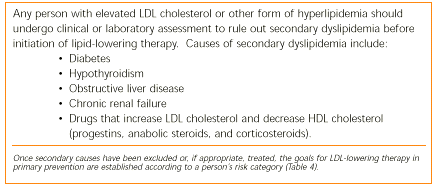
Recent clinical trials demonstrate that LDL-lowering therapy reduces total
mortality, coronary mortality, major coronary events, coronary artery
procedures, and stroke in persons with established CHD. As shown in
Table 2, an LDL cholesterol level of <100 mg/dL is optimal; therefore,
ATP III specifies an LDL cholesterol <100 mg/dL as the goal of therapy in
secondary prevention. This goal is supported by clinical trials with both
clinical and angiographic endpoints and by prospective epidemiological
studies. The same goal should apply for persons with CHD risk equivalents.
When persons are hospitalized for acute coronary syndromes or
coronary procedures, lipid measures should be taken on admission or
within 24 hours. These values can guide the physician on initiation of
LDL-lowering therapy before or at discharge. Adjustment of therapy
may be needed after 12 weeks.
The two major modalities of LDL-lowering therapy are therapeutic lifestyle
changes (TLC) and drug therapy. Both are described in more detail later.
The TLC Diet stresses reductions in saturated fat and cholesterol intakes.
When the metabolic syndrome or its associated lipid risk factors (elevated
Page 7
triglyceride or low HDL cholesterol) are present, TLC also stresses weight
reduction and increased physical activity. Table 5 defines LDL cholesterol
goals and cutpoints for initiation of TLC and for drug consideration for
persons with three categories of risk: CHD and CHD risk equivalents; multi-ple
(2+) risk factors (10-year risk 10-20% and <10%); and 0-1 risk factor.
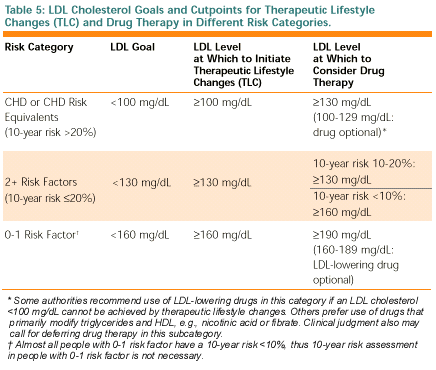
For persons with CHD and CHD risk equivalents, LDL-lowering therapy
greatly reduces risk for major coronary events and stroke and yields highly
favorable cost-effectiveness ratios. The cut-points for initiating lifestyle and
drug therapies are shown in Table 5.
 If baseline LDL cholesterol is
If baseline LDL cholesterol is  130 mg/dL, intensive lifestyle therapy and
maximal control of other risk factors should be started. Moreover, for
most patients, an LDL-lowering drug will be required to achieve an LDL
cholesterol <100 mg/dL; thus an LDL cholesterol lowering drug can be
started simultaneously with TLC to attain the goal of therapy. 130 mg/dL, intensive lifestyle therapy and
maximal control of other risk factors should be started. Moreover, for
most patients, an LDL-lowering drug will be required to achieve an LDL
cholesterol <100 mg/dL; thus an LDL cholesterol lowering drug can be
started simultaneously with TLC to attain the goal of therapy.
 If LDL cholesterol levels are 100-129 mg/dL, either at baseline or on
LDL-lowering therapy, several therapeutic approaches are available:
If LDL cholesterol levels are 100-129 mg/dL, either at baseline or on
LDL-lowering therapy, several therapeutic approaches are available:
Page 8
Initiate or intensify lifestyle and/or drug therapies specifically to
lower LDL.
Emphasize weight reduction and increased physical activity in persons
with the metabolic syndrome.
Delay use or intensification of LDL-lowering therapies and institute
treatment of other lipid or nonlipid risk factors; consider use of other
lipid-modifying drugs (e.g., nicotinic acid or fibric acid) if the patient
has elevated triglyceride or low HDL cholesterol.
 If baseline LDL cholesterol is <100 mg/dL, further LDL-lowering
therapy is not required. Patients should nonetheless be advised to follow
the TLC Diet on their own to help keep the LDL level optimal. Several
clinical trials are currently underway to assess benefit of lowering LDL
cholesterol to well below 100 mg/dL. At present, emphasis should be
placed on controlling other lipid and nonlipid risk factors and on
treatment of the metabolic syndrome, if present.
If baseline LDL cholesterol is <100 mg/dL, further LDL-lowering
therapy is not required. Patients should nonetheless be advised to follow
the TLC Diet on their own to help keep the LDL level optimal. Several
clinical trials are currently underway to assess benefit of lowering LDL
cholesterol to well below 100 mg/dL. At present, emphasis should be
placed on controlling other lipid and nonlipid risk factors and on
treatment of the metabolic syndrome, if present.
For persons with multiple (2+) risk factors and 10-year risk
 20%, intensity
of therapy is adjusted according to 10-year risk and LDL cholesterol
level. The treatment approach for each category is summarized in Table 5. 20%, intensity
of therapy is adjusted according to 10-year risk and LDL cholesterol
level. The treatment approach for each category is summarized in Table 5.
 Multiple (2+) risk factors and a 10-year risk of 10-20%. In this category,
the goal for LDL cholesterol is <130 mg/dL. The therapeutic aim is to
reduce short-term risk as well as long-term risk for CHD. If baseline
LDL cholesterol is
Multiple (2+) risk factors and a 10-year risk of 10-20%. In this category,
the goal for LDL cholesterol is <130 mg/dL. The therapeutic aim is to
reduce short-term risk as well as long-term risk for CHD. If baseline
LDL cholesterol is  130 mg/dL, TLC is initiated and maintained for
3 months. If LDL remains 130 mg/dL, TLC is initiated and maintained for
3 months. If LDL remains  130 mg/dL after 3 months of TLC,
consideration can be given to starting an LDL-lowering drug to achieve
the LDL goal of <130 mg/dL. Use of LDL-lowering drugs at this risk
level reduces CHD risk and is cost-effective. If the LDL falls to less than
130 mg/dL on TLC alone, TLC can be continued without adding drugs.
In older persons ( 130 mg/dL after 3 months of TLC,
consideration can be given to starting an LDL-lowering drug to achieve
the LDL goal of <130 mg/dL. Use of LDL-lowering drugs at this risk
level reduces CHD risk and is cost-effective. If the LDL falls to less than
130 mg/dL on TLC alone, TLC can be continued without adding drugs.
In older persons ( 65 years), clinical judgment is required for how
intensively to apply these guidelines; a variety of factors, including con-comitant
illnesses, general health status, and social issues may influence
treatment decisions and may suggest a more conservative approach. 65 years), clinical judgment is required for how
intensively to apply these guidelines; a variety of factors, including con-comitant
illnesses, general health status, and social issues may influence
treatment decisions and may suggest a more conservative approach.
 Multiple (2+) risk factors and a 10-year risk of <10%. In this
category, the goal for LDL cholesterol also is <130 mg/dL. The
therapeutic aim, however, is primarily to reduce longer-term risk. If
baseline LDL cholesterol is
Multiple (2+) risk factors and a 10-year risk of <10%. In this
category, the goal for LDL cholesterol also is <130 mg/dL. The
therapeutic aim, however, is primarily to reduce longer-term risk. If
baseline LDL cholesterol is  130 mg/dL, the TLC Diet is initiated to
reduce LDL cholesterol. If LDL is <160 mg/dL on TLC alone, it should
be continued. LDL-lowering drugs generally are not recommended
because the patient is not at high short-term risk. On the other hand, if 130 mg/dL, the TLC Diet is initiated to
reduce LDL cholesterol. If LDL is <160 mg/dL on TLC alone, it should
be continued. LDL-lowering drugs generally are not recommended
because the patient is not at high short-term risk. On the other hand, if
Page 9
LDL cholesterol is  160 mg/dL, drug therapy can be considered to
achieve an LDL cholesterol <130 mg/dL; the primary aim is to reduce
long-term risk. Cost-effectiveness is marginal, but drug therapy can be
justified to slow development of coronary atherosclerosis and to reduce
long-term risk for CHD. 160 mg/dL, drug therapy can be considered to
achieve an LDL cholesterol <130 mg/dL; the primary aim is to reduce
long-term risk. Cost-effectiveness is marginal, but drug therapy can be
justified to slow development of coronary atherosclerosis and to reduce
long-term risk for CHD.
Most persons with 0-1 risk factor have a 10-year risk <10%. They are
managed according to Table 5. The goal for LDL cholesterol in this risk
category is <160 mg/dL. The primary aim of therapy is to reduce long-term
risk. First-line therapy is TLC. If after 3 months of TLC the LDL choles-terol
is <160 mg/dL, TLC is continued. However, if LDL cholesterol is
160-189 mg/dL after an adequate trial of TLC, drug therapy is optional
depending on clinical judgment. Factors favoring use of drugs include:
 A severe single risk factor (heavy cigarette smoking, poorly controlled
hypertension, strong family history of premature CHD, or very low
HDL cholesterol);
A severe single risk factor (heavy cigarette smoking, poorly controlled
hypertension, strong family history of premature CHD, or very low
HDL cholesterol);
 Multiple life-habit risk factors and emerging risk factors (if measured);
Multiple life-habit risk factors and emerging risk factors (if measured);
 10-year risk approaching 10% (if measured; see Appendix).
10-year risk approaching 10% (if measured; see Appendix).
If LDL cholesterol is  190 mg/dL despite TLC, drug therapy should be
considered to achieve the LDL goal of <160 mg/dL. 190 mg/dL despite TLC, drug therapy should be
considered to achieve the LDL goal of <160 mg/dL.
The purpose of using LDL-lowering drugs in persons with 0-1 risk factor
and elevated LDL cholesterol ( 160 mg/dL) is to slow the development of
coronary atherosclerosis, which will reduce long-term risk. This aim may
conflict with cost-effectiveness considerations; thus, clinical judgment is
required in selection of persons for drug therapy, although a strong case can
be made for using drugs when LDL cholesterol is 160 mg/dL) is to slow the development of
coronary atherosclerosis, which will reduce long-term risk. This aim may
conflict with cost-effectiveness considerations; thus, clinical judgment is
required in selection of persons for drug therapy, although a strong case can
be made for using drugs when LDL cholesterol is  190 mg/dL after TLC. 190 mg/dL after TLC.
For persons whose LDL cholesterol levels are already below goal levels
upon first encounter, instructions for appropriate changes in life habits,
periodic followup, and control of other risk factors are needed.
Page 10
ATP III recommends a multifaceted lifestyle approach to reduce risk for
CHD. This approach is designated therapeutic lifestyle changes (TLC).
Its essential features are:
 Reduced intakes of saturated fats (<7% of total calories) and cholesterol
(<200 mg per day) (see Table 6 for overall composition of the TLC Diet)
Reduced intakes of saturated fats (<7% of total calories) and cholesterol
(<200 mg per day) (see Table 6 for overall composition of the TLC Diet)
 Therapeutic options for enhancing LDL lowering such as plant
stanols/sterols (2 g/day) and increased viscous (soluble) fiber (10-25 g/day)
Therapeutic options for enhancing LDL lowering such as plant
stanols/sterols (2 g/day) and increased viscous (soluble) fiber (10-25 g/day)
 Weight reduction
Weight reduction
 Increased physical activity
Increased physical activity
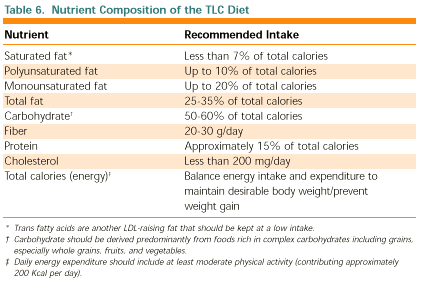
A model of steps in TLC is shown in Figure 1. To initiate TLC, intakes of
saturated fats and cholesterol are reduced first to lower LDL cholesterol.
To improve overall health, ATP III’s TLC Diet generally contains the
recommendations embodied in the Dietary Guidelines for Americans 2000.
One exception is that total fat is allowed to range from 25-35% of total
calories provided saturated fats and trans fatty acids are kept low. A higher
intake of total fat, mostly in the form of unsaturated fat, can help to reduce
triglycerides and raise HDL cholesterol in persons with the metabolic
syndrome. In accordance with the Dietary Guidelines, moderate physical
activity is encouraged. After 6 weeks, the LDL response is determined; if the
LDL cholesterol goal has not been achieved, other therapeutic options for
LDL lowering such as plant stanol/sterols and viscous fiber can be added.
After maximum reduction of LDL cholesterol with dietary therapy,
emphasis shifts to management of the metabolic syndrome and associated
lipid risk factors. The majority of persons with these latter abnormalities
are overweight or obese and sedentary. Weight reduction therapy for over-weight
or obese patients will enhance LDL lowering and will provide other
health benefits including modifying other lipid and nonlipid risk factors.
Page 11
Assistance in the management of overweight and obese persons is provided
by the Clinical Guidelines on the Identification, Evaluation, and Treatment
of Overweight and Obesity in Adults from the NHLBI Obesity Education
Initiative (1998). Additional risk reduction can be achieved by simultane-ously
increasing physical activity.
At all stages of dietary therapy, physicians are encouraged to refer patients
to registered dietitians or other qualified nutritionists for medical nutrition
therapy, which is the term for the nutritional intervention and guidance
provided by a nutrition professional.
| |
|
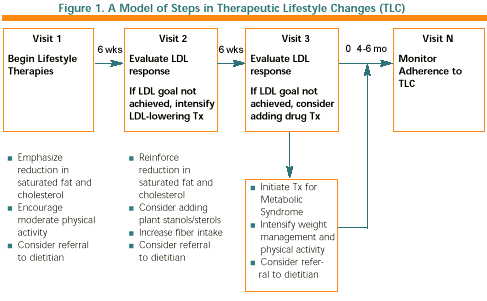
|
|
A portion of the population whose short-term or long-term risk for CHD is
high will require LDL-lowering drugs in addition to TLC to reach the desig-nated
goal for LDL cholesterol (see Table 5). When drugs are prescribed,
attention to TLC should always be maintained and reinforced. Currently
available drugs that affect lipoprotein metabolism and their major charac-teristics
are listed in Table 7.
Some cholesterol-lowering agents are currently available over-the-counter
(OTC) (e.g., nicotinic acid), and manufacturers of several classes of LDL-lowering
drugs (e.g., statins, bile acid sequestrants) have applied to the
Page 12
Food and Drug Administration (FDA) to allow these agents to become
OTC medications. At the time of publication of ATP III, the FDA has not
granted permission for OTC status for statins or bile acid sequestrants. If an
OTC cholesterol-lowering drug is or becomes available, patients should
continue to consult with their physicians about whether to initiate drug
treatment, about setting the goals of therapy, and about monitoring for
therapeutic responses and side effects.
| |
|

|
|
* Lovastatin (20-80 mg), pravastatin (20-40 mg), simvastatin (20-80 mg), fluvastatin (20-80 mg), atorvastatin (10-80 mg),
cerivastatin (0.4-0.8 mg).
† Cyclosporine, macrolide antibiotics, various antifungal agents and cytochrome P-450 inhibitors (fibrates and niacin should be
used with appropriate caution).
‡ Cholestyramine (4-16 g), colestipol (5-20 g), colesevelam (2.6-3.8 g).
¥ Immediate release (crystalline) nicotinic acid (1.5-3 g), extended release nicotinic acid (Niaspan ®) (1-2 g), sustained release
nicotinic acid (1-2 g).
§ Gemfibrozil (600 mg BID), fenofibrate (200 mg), clofibrate (1000 mg BID).
Page 13
For persons with CHD and CHD risk equivalents, the goal is to attain an
LDL cholesterol level <100 mg/dL. The cutpoints for initiating lifestyle and
drug therapies are shown in Table 5, and the approach to treatment is
discussed immediately after Table 5. Most CHD patients will need LDL-lowering
drug therapy. Other lipid risk factors may also warrant considera-tion
of drug treatment. Whether or not lipid-modifying drugs are used,
nonlipid risk factors require attention and favorable modification.
In persons admitted to the hospital for a major coronary event, LDL
cholesterol should be measured on admission or within 24 hours. This
value can be used for treatment decisions. In general, persons hospitalized
for a coronary event or procedure should be discharged on drug therapy if
the LDL cholesterol is  130 mg/dL. If the LDL is 100–129 mg/dL, clinical
judgment should be used in deciding whether to initiate drug treatment at
discharge, recognizing that LDL cholesterol levels begin to decline in the
first few hours after an event and are significantly decreased by 24-48 hours
and may remain low for many weeks. Thus, the initial LDL cholesterol level
obtained in the hospital may be substantially lower than is usual for the
patient. Some authorities hold drug therapy should be initiated whenever
a patient hospitalized for a CHD-related illness is found to have an LDL
cholesterol >100 mg/dL. Initiation of drug therapy at the time of hospital
discharge has two advantages. First, at that time patients are particularly
motivated to undertake and adhere to risk-lowering interventions; and
second, failure to initiate indicated therapy early is one of the causes of a
large “treatment gap,” because outpatient followup is often less consistent
and more fragmented. 130 mg/dL. If the LDL is 100–129 mg/dL, clinical
judgment should be used in deciding whether to initiate drug treatment at
discharge, recognizing that LDL cholesterol levels begin to decline in the
first few hours after an event and are significantly decreased by 24-48 hours
and may remain low for many weeks. Thus, the initial LDL cholesterol level
obtained in the hospital may be substantially lower than is usual for the
patient. Some authorities hold drug therapy should be initiated whenever
a patient hospitalized for a CHD-related illness is found to have an LDL
cholesterol >100 mg/dL. Initiation of drug therapy at the time of hospital
discharge has two advantages. First, at that time patients are particularly
motivated to undertake and adhere to risk-lowering interventions; and
second, failure to initiate indicated therapy early is one of the causes of a
large “treatment gap,” because outpatient followup is often less consistent
and more fragmented.
Table 5 shows the cutpoints for considering drug treatment in primary pre-vention.
The general approach to management of drug therapy for primary
prevention is outlined in Figure 2.
Page 14
| |
|
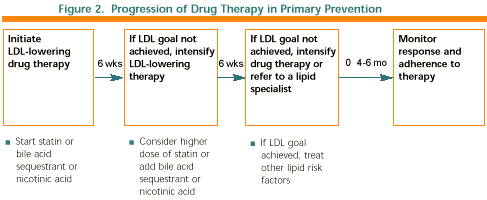
|
|
When drug therapy for primary prevention is a consideration, the third visit
of dietary therapy (see Figure 1) will typically be the visit to initiate drug
treatment. Even if drug treatment is started, TLC should be continued. As
with TLC, the first priority of drug therapy is to achieve the goal for LDL
cholesterol. For this reason, an LDL-lowering drug should be started. The
usual drug will be a statin, but alternatives are a bile acid sequestrant or
nicotinic acid. In most cases, the statin should be started at a moderate
dose. In many patients, the LDL cholesterol goal will be achieved, and high-er
doses will not be necessary. The patient’s response should be checked
about 6 weeks after starting drug therapy. If the goal of therapy has been
achieved, the current dose can be maintained. However, if the goal has not
been achieved, LDL-lowering therapy can be intensified, either by increasing
the dose of statin or by combining a statin with a bile acid sequestrant or
nicotinic acid.
After 12 weeks of drug therapy, the response to therapy should again be
assessed. If the LDL cholesterol goal is still not achieved, consideration can
be given to further intensification of drug therapy. If the LDL goal cannot
be attained by standard lipid-lowering therapy, consideration should be
given to seeking consultation from a lipid specialist. Once the goal for LDL
cholesterol has been attained, attention can turn to other lipid risk factors
and nonlipid factors. Thereafter, patients can be monitored for response to
therapy every 4 to 6 months, or more often if considered necessary.
Evidence is accumulating that risk for CHD can be reduced beyond
LDL-lowering therapy by modification of other risk factors. One potential
Page 15
secondary target of therapy is the metabolic syndrome, which represents a
constellation of lipid and nonlipid risk factors of metabolic origin. This
syndrome is closely linked to a generalized metabolic disorder called insulin
resistance in which the normal actions of insulin are impaired. Excess body
fat (particularly abdominal obesity) and physical inactivity promote the
development of insulin resistance, but some individuals also are genetically
predisposed to insulin resistance.
The risk factors of the metabolic syndrome are highly concordant; in
aggregate they enhance risk for CHD at any given LDL cholesterol level.
For purposes of ATP III, the diagnosis of the metabolic syndrome is made
when three or more of the risk determinants shown in Table 8 are present.
These determinants include a combination of categorical and borderline risk
factors that can be readily measured in clinical practice.

* Overweight and obesity are associated with insulin resistance and the metabolic syndrome. However, the
presence of abdominal obesity is more highly correlated with the metabolic risk factors than is an elevated
body mass index (BMI). Therefore, the simple measure of waist circumference is recommended to identify the
body weight component of the metabolic syndrome.
† Some male patients can develop multiple metabolic risk factors when the waist circumference is only
marginally increased, e.g., 94-102 cm (37-39 in). Such patients may have a strong genetic contribution to
insulin resistance. They should benefit from changes in life habits, similarly to men with categorical increases
in waist circumference.
Management of the metabolic syndrome has a two-fold objective: (1) to
reduce underlying causes (i.e., obesity and physical inactivity), and (2) to
treat associated nonlipid and lipid risk factors.
First-line therapies for all lipid and nonlipid risk factors associated with the
metabolic syndrome are weight reduction and increased physical activity,
which will effectively reduce all of these risk factors. Therefore, after
Page 16
appropriate control of LDL cholesterol, TLC should stress weight reduction
and physical activity if the metabolic syndrome is present.
Weight control. In ATP III overweight and obesity are recognized as major,
underlying risk factors for CHD and identified as direct targets of interven-tion.
Weight reduction will enhance LDL lowering and reduce all of the risk
factors of the metabolic syndrome. The recommended approaches for
reducing overweight and obesity are contained in the clinical guidelines of
the NHLBI Obesity Education Initiative.
Physical activity. Physical inactivity is likewise a major, underlying risk
factor for CHD. It augments the lipid and nonlipid risk factors of the meta-bolic
syndrome. It further may enhance risk by impairing cardiovascular fit-ness
and coronary blood flow. Regular physical activity reduces very low
density lipoprotein (VLDL) levels, raises HDL cholesterol, and in some
persons, lowers LDL levels. It also can lower blood pressure, reduce insulin
resistance, and favorably influence cardiovascular function. Thus, ATP III
recommends that regular physical activity become a routine component
in management of high serum cholesterol. The evidence base for this
recommendation is contained in the U.S. Surgeon General’s Report on
Physical Activity.
Beyond the underlying risk factors, therapies directed against the lipid and
nonlipid risk factors of the metabolic syndrome will reduce CHD risk.
These include treatment of hypertension, use of aspirin in patients with
CHD to reduce the prothrombotic state (guidelines for aspirin use in
primary prevention have not been firmly established), and treatment of
elevated triglycerides and low HDL cholesterol as discussed below under
Management of Specific Dyslipidemias.
Very high LDL cholesterol ( 190 mg/dL). Persons with very high LDL
cholesterol usually have genetic forms of hypercholesterolemia: monogenic
familial hypercholesterolemia, familial defective apolipoprotein B, and
polygenic hypercholesterolemia. Early detection of these disorders through
cholesterol testing in young adults is needed to prevent premature CHD.
Family testing is important to identify similarly affected relatives. These 190 mg/dL). Persons with very high LDL
cholesterol usually have genetic forms of hypercholesterolemia: monogenic
familial hypercholesterolemia, familial defective apolipoprotein B, and
polygenic hypercholesterolemia. Early detection of these disorders through
cholesterol testing in young adults is needed to prevent premature CHD.
Family testing is important to identify similarly affected relatives. These
Page 17
disorders often require combined drug therapy (statin + bile acid seques-trant)
to achieve the goals of LDL-lowering therapy.
Elevated serum triglycerides. Recent meta-analyses of prospective studies
indicate that elevated triglycerides are also an independent risk factor for
CHD. Factors contributing to elevated (higher than normal) triglycerides in
the general population include: obesity and overweight, physical inactivity,
cigarette smoking, excess alcohol intake, high carbohydrate diets (>60% of
energy intake), several diseases (e.g., type 2 diabetes, chronic renal failure,
nephrotic syndrome), certain drugs (e.g., corticosteroids, estrogens,
retinoids, higher doses of beta-adrenergic blocking agents), and genetic
disorders (familial combined hyperlipidemia, familial hypertriglyceridemia,
and familial dysbetalipoproteinemia).
In clinical practice, elevated serum triglycerides are most often observed in
persons with the metabolic syndrome, although secondary or genetic factors
can heighten triglyceride levels. ATP III adopts the following classification
of serum triglycerides:

|
Normal triglycerides:
|
<150 mg/dL
|

|
Borderline-high triglycerides:
|
150-199 mg/dL
|

|
High triglycerides:
|
200-499 mg/dL
|

|
Very high triglycerides:
|
 500 mg/dL 500 mg/dL
|
The finding that elevated triglycerides are an independent CHD risk factor
suggests that some triglyceride-rich lipoproteins are atherogenic. The latter
are partially degraded VLDL, commonly called remnant lipoproteins. In
clinical practice, VLDL cholesterol is the most readily available measure of
atherogenic remnant lipoproteins. Thus, VLDL cholesterol can be a target
of cholesterol-lowering therapy. ATP III identifies the sum of LDL+VLDL
cholesterol [termed non-HDL cholesterol (total cholesterol minus HDL
cholesterol)] as a secondary target of therapy in persons with high
triglycerides ( 200 mg/dL). The goal for non-HDL cholesterol in persons
with high serum triglycerides can be set at 30 mg/dL higher than that for
LDL cholesterol (Table 9) on the premise that a VLDL cholesterol level 200 mg/dL). The goal for non-HDL cholesterol in persons
with high serum triglycerides can be set at 30 mg/dL higher than that for
LDL cholesterol (Table 9) on the premise that a VLDL cholesterol level  30
mg/dL is normal. 30
mg/dL is normal.
The treatment strategy for elevated triglycerides depends on the causes of
the elevation and its severity. For all persons with elevated triglycerides, the
primary aim of therapy is to achieve the target goal for LDL cholesterol.
When triglycerides are borderline high (150-199 mg/dL), emphasis should
also be placed on weight reduction and increased physical activity. For high
triglycerides (200-499 mg/dL), non-HDL cholesterol becomes a secondary
Page 18

target of therapy. Aside from weight reduction and increased physical activity,
drug therapy can be considered in high-risk persons to achieve the non-HDL
cholesterol goal. There are two approaches to drug therapy. First, the
non-HDL cholesterol goal can be achieved by intensifying therapy with an
LDL-lowering drug; or second, nicotinic acid or fibrate can be added, if
used with appropriate caution, to achieve the non-HDL cholesterol goal by
further lowering of VLDL cholesterol. In rare cases in which triglycerides
are very high ( 500 mg/dL), the initial aim of therapy is to prevent acute
pancreatitis through triglyceride lowering. This approach requires very low
fat diets ( 500 mg/dL), the initial aim of therapy is to prevent acute
pancreatitis through triglyceride lowering. This approach requires very low
fat diets ( 15% of calorie intake), weight reduction, increased physical
activity, and usually a triglyceride-lowering drug (fibrate or nicotinic acid).
Only after triglyceride levels have been lowered to <500 mg/dL should
attention turn to LDL lowering to reduce risk for CHD. 15% of calorie intake), weight reduction, increased physical
activity, and usually a triglyceride-lowering drug (fibrate or nicotinic acid).
Only after triglyceride levels have been lowered to <500 mg/dL should
attention turn to LDL lowering to reduce risk for CHD.
Low HDL cholesterol. Low HDL cholesterol is a strong independent
predictor of CHD. In ATP III, low HDL cholesterol is defined categorically
as a level <40 mg/dL, a change from the level of <35 mg/dL in ATP II. In
the present guidelines, low HDL cholesterol both modifies the goal for
LDL-lowering therapy and is used as a risk factor to estimate 10-year risk
for CHD.
Low HDL cholesterol levels have several causes, many of which are
associated with insulin resistance, i.e., elevated triglycerides, overweight and
obesity, physical inactivity, and type 2 diabetes. Other causes are cigarette
smoking, very high carbohydrate intakes (>60% of calories), and certain
drugs (e.g., beta-blockers, anabolic steroids, progestational agents)
ATP III does not specify a goal for HDL raising. Although clinical trial
results suggest that raising HDL will reduce risk, the evidence is insufficient
to specify a goal of therapy. Furthermore, currently available drugs do not
robustly raise HDL cholesterol. Nonetheless, a low HDL should receive
clinical attention and management according to the following sequence. In
all persons with low HDL cholesterol, the primary target of therapy is LDL
Page 19
cholesterol; ATP III guidelines should be followed to achieve the LDL cholesterol
goal. Second, after the LDL goal has been reached, emphasis shifts
to weight reduction and increased physical activity (when the metabolic
syndrome is present). When a low HDL cholesterol is associated with high
triglycerides (200-499 mg/dL), secondary priority goes to achieving the non-HDL
cholesterol goal, as outlined before. Also, if triglycerides are <200
mg/dL (isolated low HDL cholesterol), drugs for HDL raising (fibrates or
nicotinic acid) can be considered; however, treatment for isolated low HDL
is mostly reserved for persons with CHD and CHD risk equivalents.
Diabetic dyslipidemia. This disorder is essentially atherogenic dyslipidemia
(high triglycerides, low HDL, and small dense LDL) in persons with type 2
diabetes. Although elevated triglycerides and/or low HDL cholesterol are
common in persons with diabetes, clinical trial results support the identification
of LDL cholesterol as the primary target of therapy, as it is in those
without diabetes. Since diabetes is designated a CHD risk equivalent in ATP
III, the LDL cholesterol goal of therapy for most persons with diabetes will
be <100 mg/dL. Furthermore, when LDL cholesterol is
 130 mg/dL, most
persons with diabetes will require initiation of LDL-lowering drugs simultaneously
with TLC to achieve the LDL goal. When LDL cholesterol levels
are in the range of 100-129 mg/dL at baseline or on treatment, several therapeutic
options are available: increasing intensity of LDL-lowering therapy,
adding a drug to modify atherogenic dyslipidemia (fibrate or nicotinic acid),
or intensifying control of other risk factors including hyperglycemia. When
triglyceride levels are 130 mg/dL, most
persons with diabetes will require initiation of LDL-lowering drugs simultaneously
with TLC to achieve the LDL goal. When LDL cholesterol levels
are in the range of 100-129 mg/dL at baseline or on treatment, several therapeutic
options are available: increasing intensity of LDL-lowering therapy,
adding a drug to modify atherogenic dyslipidemia (fibrate or nicotinic acid),
or intensifying control of other risk factors including hyperglycemia. When
triglyceride levels are
 200 mg/dL, non-HDL cholesterol becomes a secondary
target of cholesterol-lowering therapy. Several ongoing clinical trials
(e.g., Antihypertensive and Lipid Lowering Heart Attack Trial [ALLHAT])
will better quantify the magnitude of the benefit of LDL-lowering treatment
in older individuals with diabetes. In older persons
(
200 mg/dL, non-HDL cholesterol becomes a secondary
target of cholesterol-lowering therapy. Several ongoing clinical trials
(e.g., Antihypertensive and Lipid Lowering Heart Attack Trial [ALLHAT])
will better quantify the magnitude of the benefit of LDL-lowering treatment
in older individuals with diabetes. In older persons
( 65 years of age) with
diabetes but no additional CHD risk factors other than age, clinical judgment
is required for how intensively to apply these guidelines; a variety of
factors, including concomitant illnesses, general health status, and social
issues may influence treatment decisions and may suggest a more conservative
approach. 65 years of age) with
diabetes but no additional CHD risk factors other than age, clinical judgment
is required for how intensively to apply these guidelines; a variety of
factors, including concomitant illnesses, general health status, and social
issues may influence treatment decisions and may suggest a more conservative
approach.
Middle-aged men (35-65 years). In general, men have a higher risk for CHD
than do women. Middle-aged men in particular have a high prevalence of
the major risk factors and are predisposed to abdominal obesity and the
metabolic syndrome. A sizable fraction of all CHD in men occurs in middle
age. Thus, many middle-aged men carry a relatively high risk for CHD, and
for those who do, intensive LDL-lowering therapy is needed.
Page 20
Women (ages 45-75 years). In women, onset of CHD generally is delayed
by some 10-15 years compared with that in men; thus most CHD in
women occurs after age 65. All risk factors contribute to CHD in women,
and most premature CHD in women (<65 years) occurs in those with multiple
risk factors and the metabolic syndrome. Despite the previous belief
that the gender difference in risk for CHD reflects a protective effect of
estrogen in women, recent secondary and primary prevention trials cast
doubt on the use of hormone replacement therapy to reduce CHD risk in
postmenopausal women. In contrast, the favorable effects of statin therapy
in women in clinical trials make a cholesterol-lowering drug preferable to
hormone replacement therapy for CHD risk reduction. Women should be
treated similarly to men for secondary prevention. For primary prevention,
ATP III’s general approach is similarly applicable for women and men.
However, the later onset of CHD for women in general should be factored
into clinical decisions about use of cholesterol-lowering drugs.
Older adults (men  65 years and women
65 years and women  75 years). Overall, most new
CHD events and most coronary deaths occur in older persons
(
75 years). Overall, most new
CHD events and most coronary deaths occur in older persons
( 65 years).
A high level of LDL cholesterol and low HDL cholesterol still carry predictive
power for the development of CHD in older persons. Nevertheless, the
finding of advanced subclinical atherosclerosis by noninvasive testing can be
helpful for confirming the presence of high risk in older persons. Secondary
prevention trials with statins have included a sizable number of older persons,
mostly in the age range of 65 to 75 years. In these trials, older persons
showed significant risk reduction with statin therapy. Thus, no hard-and-fast
age restrictions appear necessary when selecting persons with established
CHD for LDL-lowering therapy. For primary prevention, TLC is the
first line of therapy for older persons. However, LDL-lowering drugs can
also be considered when older persons are at higher risk because of multiple
risk factors or advanced subclinical atherosclerosis. 65 years).
A high level of LDL cholesterol and low HDL cholesterol still carry predictive
power for the development of CHD in older persons. Nevertheless, the
finding of advanced subclinical atherosclerosis by noninvasive testing can be
helpful for confirming the presence of high risk in older persons. Secondary
prevention trials with statins have included a sizable number of older persons,
mostly in the age range of 65 to 75 years. In these trials, older persons
showed significant risk reduction with statin therapy. Thus, no hard-and-fast
age restrictions appear necessary when selecting persons with established
CHD for LDL-lowering therapy. For primary prevention, TLC is the
first line of therapy for older persons. However, LDL-lowering drugs can
also be considered when older persons are at higher risk because of multiple
risk factors or advanced subclinical atherosclerosis.
Younger adults (men 20-35 years; women 20-45 years). CHD is rare except
in those with severe risk factors, e.g., familial hypercholesterolemia, heavy
cigarette smoking, or diabetes. Even though clinical CHD is relatively rare
in young adults, coronary atherosclerosis in its early stages may progress
rapidly. The rate of development of coronary atherosclerosis earlier in life
correlates with the major risk factors. In particular, long-term prospective
studies reveal that elevated serum cholesterol detected in young adulthood
predicts a higher rate of premature CHD in middle age. Thus, risk factor
identification in young adults is an important aim for long-term prevention.
The combination of early detection and early intervention on elevated LDL
cholesterol with life-habit changes offers the opportunity for delaying or
preventing onset of CHD later in life. For young adults with LDL cholesterol
levels  130 mg/dL, TLC should be instituted and emphasized.
130 mg/dL, TLC should be instituted and emphasized.
Page 21
Particular attention should be given to young men who smoke and have a
high LDL cholesterol (160-189 mg/dL); they may be candidates for
LDL-lowering drugs. When young adults have very high LDL cholesterol
levels ( 190 mg/dL),
drug therapy should be considered, as in other adults.
Those with severe genetic forms of hypercholesterolemia may require
LDL-lowering drugs in combination (e.g., statin + bile acid sequestrant). 190 mg/dL),
drug therapy should be considered, as in other adults.
Those with severe genetic forms of hypercholesterolemia may require
LDL-lowering drugs in combination (e.g., statin + bile acid sequestrant).
Racial and ethnic groups. African Americans have the highest overall CHD
mortality rate and the highest out-of-hospital coronary death rates of any
ethnic group in the United States, particularly at younger ages. Although the
reasons for the excess CHD mortality among African Americans have not
been fully elucidated, it can be accounted for, at least in part, by the high
prevalence of coronary risk factors. Hypertension, left ventricular hypertro-phy,
diabetes mellitus, cigarette smoking, obesity, physical inactivity, and
multiple CHD risk factors all occur more frequently in African Americans
than in whites. Other ethnic groups and minority populations in the United
States include Hispanics, Native Americans, Asian and Pacific Islanders, and
South Asians. Although limited data suggest that racial and ethnic groups
vary somewhat in baseline risk for CHD, this evidence did not appear
sufficient to lead the ATP III panel to modify general recommendations for
cholesterol management in these populations.
Adherence to the ATP III guidelines by both patients and providers is a key
to approximating the magnitude of the benefits demonstrated in clinical
trials of cholesterol lowering. Adherence issues have to be addressed in
order to attain the highest possible levels of CHD risk reduction. Thus,
ATP III recommends the use of state-of-the-art multidisciplinary methods
targeting the patient, providers, and health delivery systems to achieve the
full population effectiveness of the guidelines for primary and secondary
prevention (Table 10).
Page 22
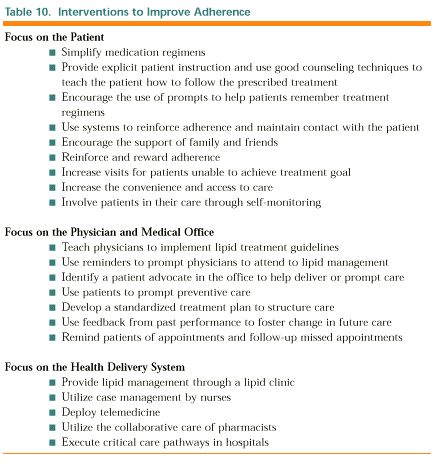
Page 23
ATP III shares a set of core features with ATP III. These are shown in Table A.
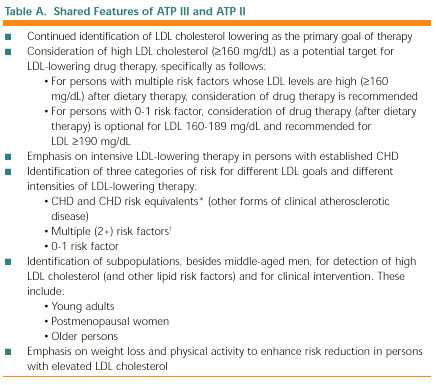
* A CHD risk equivalent is a condition that carries an absolute risk for developing new CHD equal to the risk for
having recurrent CHD events in persons with established CHD.
† Risk factors that continue to modify the LDL goal include cigarette smoking, hypertension, low HDL
cholesterol, family history of premature CHD, age (male >45 years and female >55 years), and diabetes
(in ATP III diabetes is regarded as a CHD risk equivalent).
Page 24
Risk assessment for determining the 10-year risk for developing CHD is
carried out using Framingham risk scoring (Table B1 for men and Table B2
for women). The risk factors included in the Framingham calculation of
10-year risk are: age, total cholesterol, HDL cholesterol, systolic blood
pressure, treatment for hypertension, and cigarette smoking. The first step is
to calculate the number of points for each risk factor. For initial assessment,
values for total cholesterol and HDL cholesterol are required. Because of a
larger database, Framingham estimates are more robust for total cholesterol
than for LDL cholesterol. Note, however, that the LDL cholesterol level
remains the primary target of therapy. Total cholesterol and HDL
cholesterol values should be the average of at least two measurements
obtained from lipoprotein analysis. The blood pressure value used is that
obtained at the time of assessment, regardless of whether the person is on
anti-hypertensive therapy. However, if the person is on antihypertensive
treatment, an extra point is added beyond points for the blood pressure
reading because treated hypertension carries residual risk (see Tables B1 and
B2). The average of several blood pressure measurements, as recommended
by the Joint National Committee (JNC), is needed for an accurate measure
of baseline blood pressure. The designation “smoker” means any cigarette
smoking in the past month. The total risk score sums the points for each
risk factor. The 10-year risk for myocardial infarction and coronary death
(hard CHD) is estimated from total points, and the person is categorized
according to absolute 10-year risk as indicated above (see Table 5).
Page 25

Page 26

Page 27
The acknowledgments section has been edited in a separate page
( Acknowledgements).
U.S. DEPARTMENT OF HEALTH AND HUMAN SERVICES
Public Health Service
National Institutes of Health
National Heart, Lung, and Blood Institute
NIH Publication No. 01-3670
May 2001

Important Notice: This page presents the exact version (text, tables, figures) of the NIH Publication No. 01-3670.
Third Report of the NCEP ATP III (PDF format
-adobe acrobat 113KB-).
Page numbers as in the original document are included. Some formatting has been adapted to HTML
(including anchors and hyperlinks for easier navigation).
| |
| |
 End Contents
End Contents | |
|